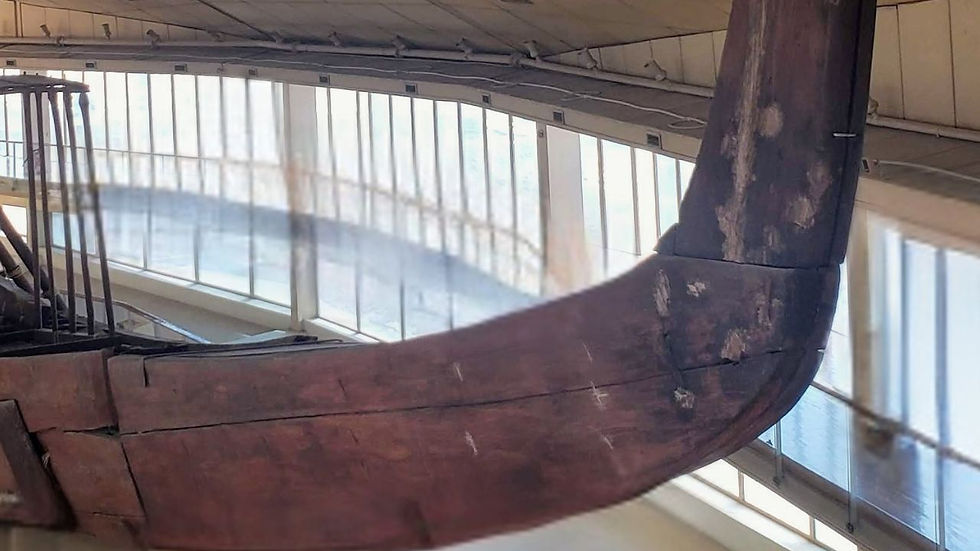This Isn’t Just a Boat — It’s a Black History Power Move Buried in the Desert | Khufu Ship
- Toni Reid
- Aug 6
- 3 min read

Let’s get one thing straight: Africans were building boats for gods before Europeans figured out how to not fall off a canoe.
Tucked behind the Great Pyramid of Giza — yes, that one — is a 144-foot-long cedarwood ship that was buried over 4,600 years ago for Pharaoh Khufu’s final journey. It’s called the Khufu Ship, and no, it’s not some old-timey sailboat with a romantic backstory and an overpriced Airbnb. This is a solar-powered (in spirit, not tech) vessel that was meant to carry the pharaoh into the afterlife. Not symbolically. Literally. That’s how serious they were about travel.
The kicker? The boat was buried in pieces, hidden for millennia, and dug up in 1954 by a local Egyptian restorer named Kamal el-Mallakh — basically the Indiana Jones of shipbuilding. It took years to put it back together, plank by plank, without a single nail. Because apparently, 4th Dynasty Egyptians were also carpentry gods.

So Why Should You Care About a Boat That Never Sailed?
Because if you’re African-American, this ship tells a story that predates trauma. Before the chains. Before the cargo holds. Before the Middle Passage.
It’s a floating reminder that African civilizations didn’t begin with slavery — they began with engineering, astronomy, philosophy, and yes, maritime genius. The Khufu Ship was not made for fishing trips. It was designed with religious precision, celestial mapping, and spiritual function. It was buried to carry one man’s soul into the heavens — a far cry from the ships that would later rip millions from their homeland and erase everything this boat represents.
So yes, it's just a boat. But also, it’s so much more than a boat.

What It Feels Like to See It in Person
Picture this: You’ve just elbowed your way past pyramid photo mobs, camel hustlers, and a guy selling fake papyrus bookmarks with "Michael Jackson" hieroglyphs. Then suddenly — silence.
Inside the Grand Egyptian Museum, a single massive vessel sits suspended in a sleek, modern space that smells faintly like wood, dust, and ancient intention. It's so well-preserved it almost dares you to touch it — don't, unless you want Egyptian security on you faster than you can say “Mummy Returns.”
It’s elegant. Complex. Deadly quiet. Like a whisper from 2,600 BCE saying, "Remember who we were before they told you who we were."

What This Has to Do with African-Americans Today
Let’s be real: African-American history is often taught like it starts on a boat. But it didn’t. It started in places like Giza, Axum, Timbuktu, Kush.
This ship isn’t just ancient Egyptian history — it’s African history. It’s your history. And unlike most Black historical references in the U.S., this one isn’t behind glass because of tragedy. It’s behind glass because of reverence.
For travelers who want to connect the dots, this is more than a photo op. It's a correction. A reckoning. A way to stand in front of something whole, powerful, and untouched by colonizers — and feel pride that runs deeper than any transatlantic scar.
Pro Tips If You’re Planning to Visit
Go early. Pyramid crowds get intense by 10AM. You want breathing room for this one.
Find the Grand Egyptian Museum (GEM). The Khufu Ship was moved from its old structure beside the Pyramid and now lives in GEM’s clean, temperature-controlled glory.
Take the detour. Most folks rush past this exhibit. Don’t be like them. Linger. Read. Let it hit you.

Talk to people. Museum staff, guides, other travelers — you’ll be surprised how few know the deeper story here. That’s your cue to drop some knowledge.
This Is the Kind of Travel That Sticks
You’re not just crossing Egypt off a bucket list. You're walking back into a narrative that was taken from you and saying, “I see it now.” You’re reclaiming maritime Blackness that didn’t start with bondage. You’re witnessing evidence — not legend, not myth — that Africans navigated eternity long before Europe even had a compass.
So go see the Khufu Ship. Then keep digging. Keep traveling. Keep asking what else they didn’t teach us in school.

Keep the Culture Coming
📌 Check out my other Egypt blogs here. 🎥 Don’t miss my Egypt video playlist on YouTube — including pyramids, Nubian villages here, and Cairo chaos. 📬 Subscribe to get the Culture Crew blog delivered straight to your inbox every week. No fluff. Just the real stories behind the passport stamps.
Because travel shouldn’t just move you — it should change you.





Comments